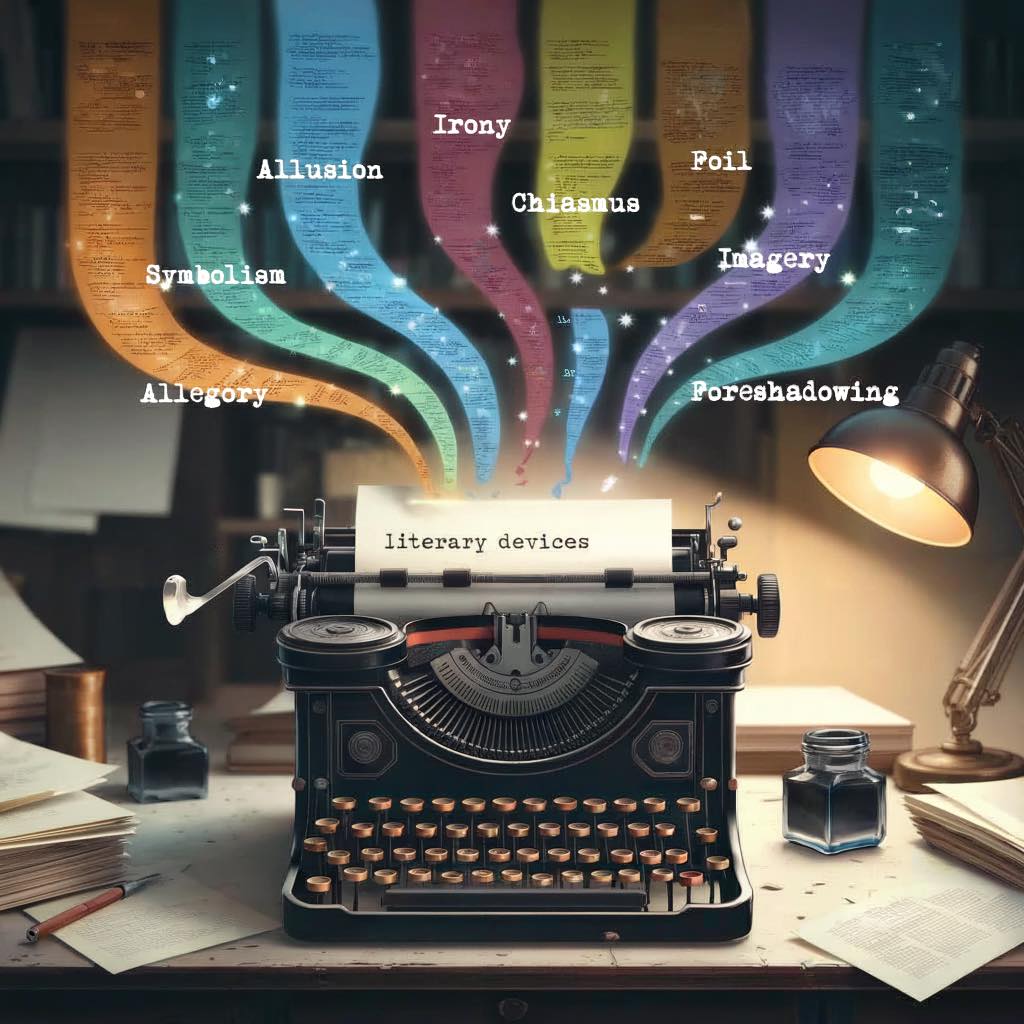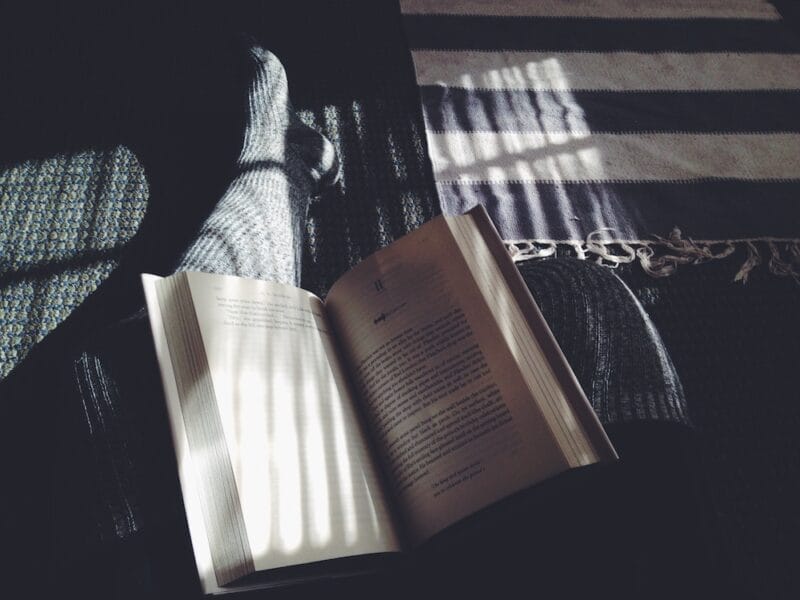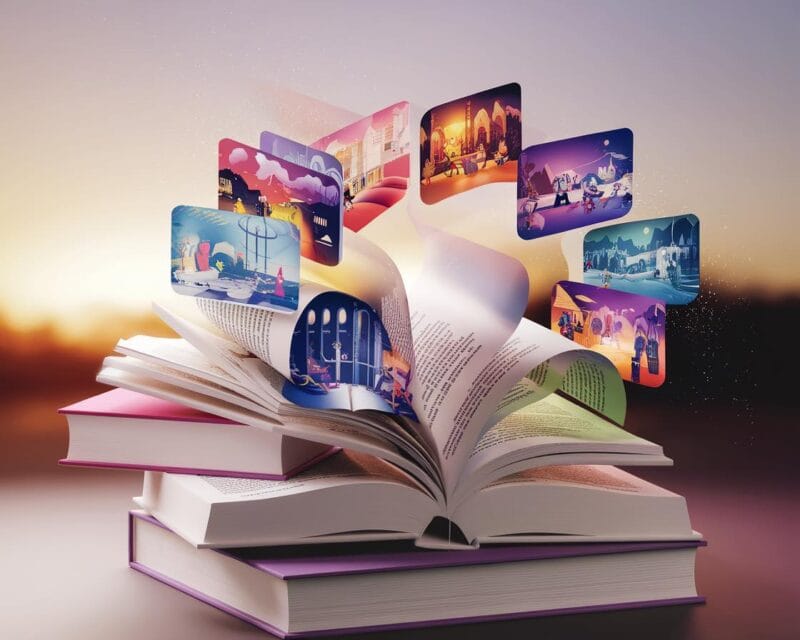- Literary devices are essential tools for enriching writing and enhancing its impact. They help writers shape language into vivid and engaging forms, which make narratives operate on multiple levels.
- Techniques like metaphor, simile, and personification bring abstract ideas to life, while devices such as irony, juxtaposition, and symbolism add texture and dimension to storytelling.
- Recognizing literary devices involves identifying patterns and understanding their role in conveying meaning. Writers use these tools to evoke emotion, establish tone, and create cohesion when crafting narratives that resonate deeply.
- Dialogue, imagery, and structural choices are particularly fertile areas for employing literary techniques effectively.
- The evolution of literary devices reflects the adaptability of language. Emerging techniques, such as neologisms, demonstrate how writers continue to innovate while maintaining the timeless function of these tools.
- When skillfully applied, literary devices create stories that are immersive, thought-provoking, and enduring.
Understanding literary devices enriches our appreciation of literature by revealing how writers shape language to convey layered meanings. These tools, which include metaphor, simile, and alliteration, among others, enhance the vitality of texts, making them resonate powerfully. They provide writers with ways to explore challenging themes and articulate intricate emotions.
For those who enjoy literature, recognizing literary devices can transform passive engagement into active interpretation. Identifying these devices not only improves comprehension but also cultivates an admiration for the craft that makes great storytelling so impactful.
Writers utilize various literary devices to create layered and rich meanings. For them, these tools are indispensable for shaping narratives that leave a lasting impression, providing both precision and subtlety in their expression. Before we proceed further, we first need to address the question, What is a literary device?
What are literary devices?
Definition of Literary Devices
Literary devices are deliberate techniques used to add depth, clarity, and artistry to a piece of writing. They go beyond mere ornamentation, serving as functional elements that guide meaning, evoke imagery, and enhance rhythm. Writers employ them to craft layers of interpretation, ensuring that their work can resonate differently with each reader’s perspective.
Consider the metaphor. By describing a character’s emotional turmoil as “a storm gathering on the horizon,” a writer not only illustrates internal conflict but also evokes the inevitable release of tension. Similes, likewise, create vivid comparisons: “Her voice was as soft as falling snow” captures both the gentleness and ephemeral quality of a fleeting moment.
Personification, another powerful tool, grants human characteristics to nonhuman entities, lending them relatability and evocative power. A description like “the clock watched them with quiet disdain” transforms an inanimate object into an active participant in the narrative, subtly reinforcing themes of judgment or time’s relentless march.
The Role of Literary Devices in Writing
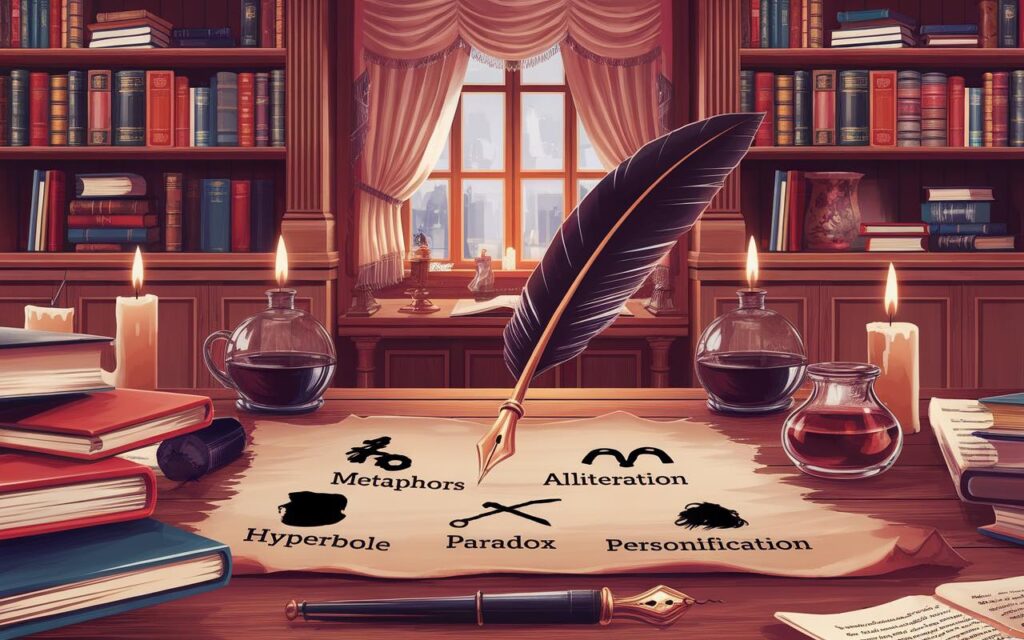
Through their deliberate use, literary devices help writers craft texts that operate on multiple levels. They create a dynamic interaction between form and content, where the style of writing becomes inseparable from its substance. This interplay creates a rich textual environment where every element, from word choice to sentence structure, contributes to the broader narrative or thematic goals.
By employing literary devices, writers can guide readers through subtle shifts in meaning or tone, often creating moments of revelation or reflection that resonate deeply. These tools also establish coherence within a work, tying disparate elements together into a unified whole. Whether through the manipulation of language or the orchestration of narrative patterns, literary devices are instrumental in shaping the way a text unfolds and how its ideas are perceived.
Beyond their role in crafting individual works, literary devices are central to the way literature engages with broader questions about language and expression. They provide writers with the tools to explore abstract concepts, construct imaginative worlds, and articulate the nuances of human thought and emotion. By framing ideas in inventive ways, literary works using these devices inspire readers to think critically and interpret them creatively.
In addition to enhancing meaning, literary devices also contribute to the musicality and texture of writing. The sounds, rhythms, and cadences created through specific techniques make language more evocative and memorable. These stylistic literary devices enrich the sensory dimension of a text, transforming it from a collection of sentences into a living, breathing entity.
By experimenting with form and technique, literary devices can redefine traditional structures and introduce innovative approaches to storytelling. This creative flexibility ensures that literature remains a dynamic and evolving medium, capable of capturing the complexities of the world in new and compelling ways.
Types of Literary Devices
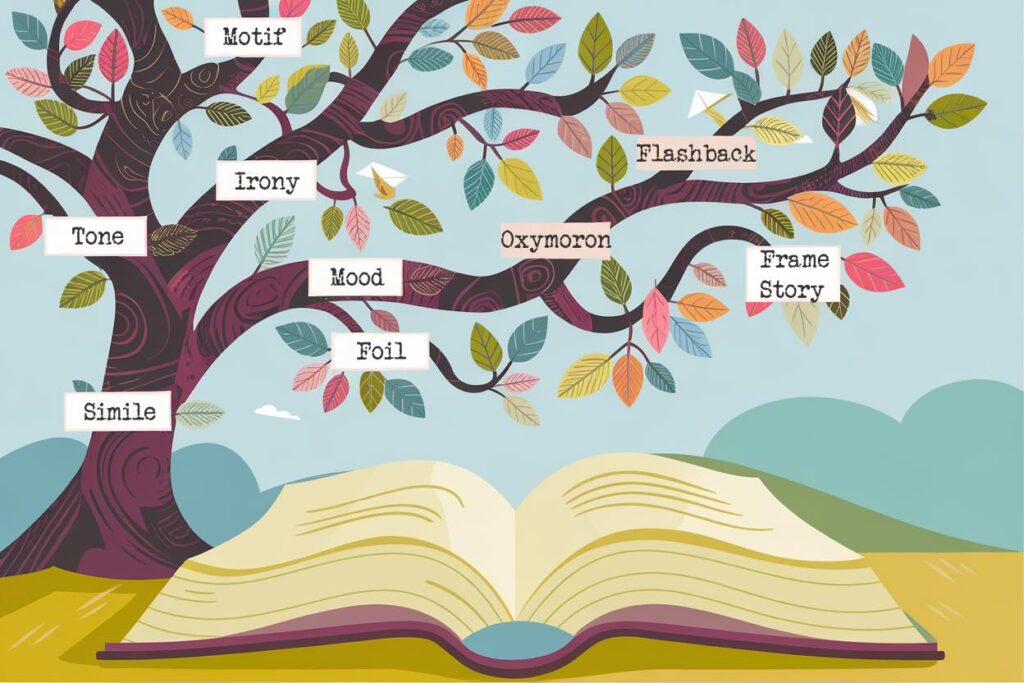
While it is impossible to cover every literary device in a single discussion, the following list aims to highlight the most essential and widely used tools. These devices have endured over time, appearing consistently in both classic and modern works, and are invaluable for writers seeking to refine their craft and readers seeking to engage more deeply with the text.
Metaphor and Simile
- Metaphor: Creates implicit comparisons by stating one thing is another, distilling abstract or complex ideas into vivid, relatable imagery. Example: “Hope is the thing with feathers” (Emily Dickinson).
- Simile: Explicitly compares two things using “like” or “as.” Example: “Her smile was as bright as the morning sun.”
Symbolism and Motif
- Symbolism: Embeds deeper meaning into objects, characters, or settings. Example: The green light in F. Scott Fitzgerald’s The Great Gatsby (1925).
- Motif: A recurring element that reinforces themes. Example: The use of doubles in Dostoevsky’s The Double (1846).
Personification and Anthropomorphism
- Personification: Attributes human characteristics to inanimate objects. Example: “The leaves danced in the wind.”
- Anthropomorphism: Assigns human traits or emotions to animals or objects as characters. Example: The pigs in George Orwell’s Animal Farm (1945).
Juxtaposition and Contrast
- Juxtaposition: Places contrasting ideas side by side for emphasis. Example: “It was the best of times, it was the worst of times” (Charles Dickens, A Tale of Two Cities, 1859).
- Contrast: Highlights differences between two elements to sharpen meaning or tension.
Allegory and Ekphrasis
- Allegory: Uses narrative or characters to represent larger moral, political, or philosophical ideas. Example: Pilgrim’s Progress by John Bunyan (1678).
- Ekphrasis: Vividly describes art within literature. Example: John Keats’ “Ode on a Grecian Urn” (1819).
Imagery and Sensory Details
- Imagery: Evokes sensory experiences through detailed descriptions. Example: “The crimson petals of the rose drooped in the fading light.”
- Sensory Detail: Engages multiple senses to immerse readers.
Irony
- Dramatic Irony: The audience knows something the characters do not. Example: Oedipus Rex by Sophocles (429 BCE).
- Situational Irony: When outcomes defy expectations. Example: A fire station burns down.
- Verbal Irony: A statement where the intended meaning contrasts with the literal meaning. Example: Saying “What a pleasant day” during a storm.
Paradox and Oxymoron
- Paradox: Contradictory statements that reveal deeper truths. Example: “Less is more.”
- Oxymoron: Combines contradictory terms. Example: “Deafening silence.”
Allusion
- Definition: References to external works, events, or figures to add layers of meaning. Example: T. S. Eliot’s The Waste Land (1922) references mythology, religion, and literature.
Hyperbole and Understatement
- Hyperbole: Exaggerates for emphasis. Example: “I’ve told you a million times.”
- Understatement: Deliberately minimizes significance. Example: “It’s just a scratch” (for a large wound).
Foreshadowing
- Definition: Provides hints or clues about future events. Example: The recurring dreams in Gabriel García Márquez’s Chronicle of a Death Foretold (1981).
Flashback and Flashforward
- Flashback: Depicts past events to provide context or background. Example: The fragmented narrative in William Faulkner’s The Sound and the Fury (1929).
- Flashforward: Depicts future events to create anticipation or tension.
Frame Story
- Definition: A narrative that contains another story within it. Example: Mary Shelley’s Frankenstein (1818).
Tone and Mood
- Tone: Reflects the author’s attitude toward the subject. Example: Sarcastic tone in Jonathan Swift’s A Modest Proposal (1729).
- Mood: Evokes an emotional response in the audience. Example: The haunting atmosphere of Edgar Allan Poe’s “The Fall of the House of Usher” (1839).
Alliteration, Assonance, and Consonance
- Alliteration: Repetition of initial consonant sounds. Example: “She sells seashells by the seashore.”
- Assonance: Repetition of vowel sounds. Example: “The rain in Spain falls mainly in the plain.”
- Consonance: Repetition of consonant sounds. Example: “The lumpy, bumpy road.”
Anaphora and Epistrophe
- Anaphora: Repetition of words or phrases at the beginning of successive clauses. Example: Martin Luther King Jr.’s “I Have a Dream” speech.
- Epistrophe: Repetition of words at the end of successive clauses. Example: “…government of the people, by the people, for the people” (Abraham Lincoln).
Chiasmus and Antithesis
- Chiasmus: Reversal of grammatical structures for emphasis. Example: “Ask not what your country can do for you—ask what you can do for your country” (John F. Kennedy).
- Antithesis: Contrasting ideas presented in parallel structure. Example: “To err is human; to forgive, divine” (Alexander Pope).
Apostrophe
- Definition: Directly addressing an absent or imaginary person, or an abstraction. Example: “O Death, where is thy sting?”
Foil
- Definition: A character who contrasts with another to highlight qualities. Example: Dr. Jekyll and Mr. Hyde in Robert Louis Stevenson’s Strange Case of Dr Jekyll and Mr Hyde (1886).
Euphemism and Dysphemism
- Euphemism: A polite expression replacing harsh ones. Example: “Passed away” instead of “died.”
- Dysphemism: A harsh expression replacing mild ones. Example: “Kicked the bucket.”
Synecdoche and Metonymy
- Synecdoche: Uses a part to represent the whole. Example: “All hands on deck.”
- Metonymy: Substitutes a related term for the thing itself. Example: “The crown” for monarchy.
Archetype
- Definition: A universal symbol or character type. Example: The hero’s journey in Joseph Campbell’s The Hero with a Thousand Faces (1949).
Polysyndeton and Asyndeton
- Polysyndeton: Repetition of conjunctions for emphasis. Example: “We have ships and men and money and stores.”
- Asyndeton: Omission of conjunctions. Example: “I came, I saw, I conquered.”
Enjambment and Caesura
- Enjambment: Continuation of a sentence without pause beyond a line of poetry. Example: William Carlos Williams’ “The Red Wheelbarrow” (1923).
- Caesura: A pause within a line of poetry. Example: “To be, or not to be— that is the question” (William Shakespeare).
Stream of Consciousness
- Definition: A narrative style that mimics the flow of thoughts. Example: James Joyce’s Ulysses (1922).
Examples of Literary Devices
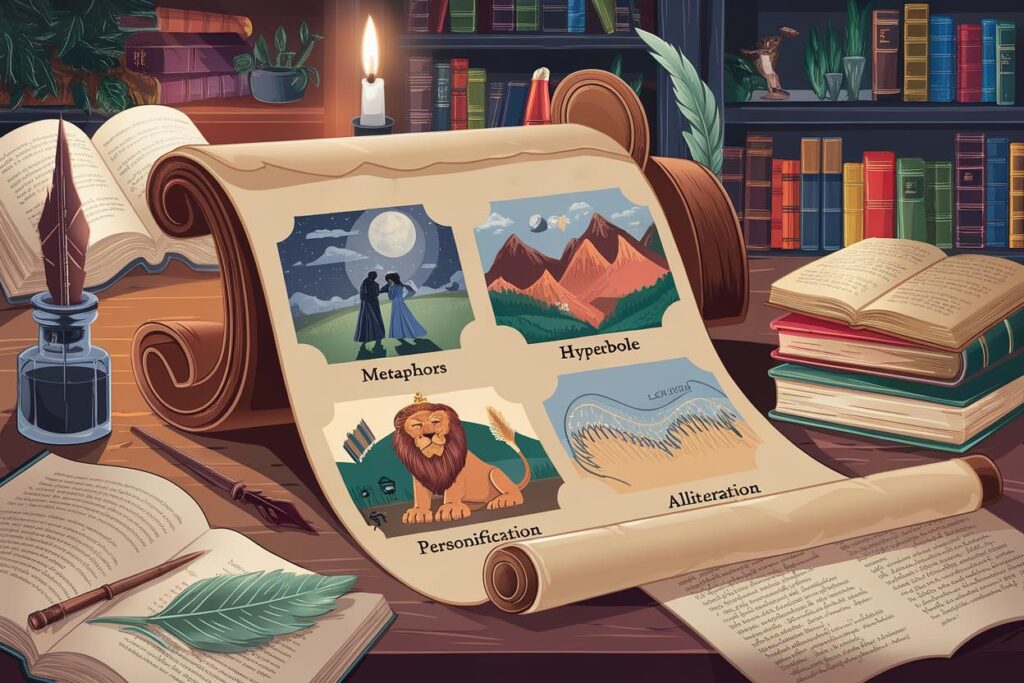
Classic Literature
William Shakespeare’s Macbeth (1606) employs a range of devices to explore ambition, power, and guilt. Symbolism is particularly prominent, as the recurring motif of blood signifies the irreversible nature of violence and the weight of moral consequence. Lines such as “Out, damned spot!” reflect Lady Macbeth’s psychological unraveling and her inability to escape guilt. Additionally, dramatic irony is used effectively, as the audience is aware of Macbeth’s treachery while other characters remain oblivious, heightening the tension.
Moreover, the oxymoron that juxtaposes opposing words also stands as one of the most prominent literary devices in the classics. Shakespeare frequently used this device to highlight the inherent contradictions of human nature. Phrases such as “loving hate” and “sweet sorrow” (Romeo and Juliet, 1597) reflect the paradoxical nature of our experiences. This device provides a layered, intricate, and dynamic portrayal that resonates deeply with readers, reflecting the multifaceted nature of existence.
Dante Alighieri’s Divine Comedy (1320), meanwhile, stands as one of the most profound examples of allegory in literature. The entire narrative functions as a representation of the human soul’s journey toward salvation. Virgil, who guides Dante through Hell and Purgatory, symbolizes human reason, while Beatrice represents divine love. Imagery saturates the text, from the gruesome depictions of sinners in Inferno to the celestial beauty of Paradiso, making the moral and theological messages both vivid and enduring.
Yet another intriguing narrative device is the frame story, an overarching narrative that contains another story inside it. Geoffrey Chaucer’s The Canterbury Tales (1392) uses this device to perfection. Every single story is placed within the broader narrative of the pilgrimage, allowing for powerful storytelling that reflects the complexities of culture, faith, and loss.
Furthermore, Herman Melville’s Moby-Dick (1851) is replete with symbolism and metaphor. The white whale itself serves as a multifaceted symbol, representing obsession, the sublime, and the unknowable forces of nature. The Pequod, Ahab’s doomed ship, becomes a microcosm of society, with its diverse crew representing humanity’s varied backgrounds and perspectives. Additionally, Melville’s use of allusion—drawing from the Bible, mythology, and Shakespeare—enriches the narrative’s depth.
In Charlotte Brontë’s Jane Eyre (1847), gothic imagery heightens the novel’s emotional and psychological intensity. The fire at Thornfield Hall symbolizes both destruction and purification, mirroring the tumultuous relationship between Jane and Rochester. The recurring motif of the “red room” embodies fear, repression, and Jane’s struggles against external pressures and personal limitations.
Modern Literature
Modern literature further evolves the use of literary devices, but in a modern way. George Orwell’s Nineteen Eighty-Four (1949) uses literary devices to critique totalitarianism and the manipulation of truth. The concept of Newspeak symbolizes the erosion of free thought through the control of language. Irony is pervasive, especially in the Party’s slogans such as “War is Peace” and “Freedom is Slavery,” which reflect the paradoxical nature of authoritarian propaganda. Symbolism is also key, with the glass paperweight representing Winston’s fragile hopes for individuality and connection.
Furthermore, García Márquez’s One Hundred Years of Solitude (1967) exemplifies magical realism, blending fantastical occurrences with a grounded, historical setting. The rain of yellow flowers upon José Arcadio Buendía’s death symbolizes the merging of the natural and the supernatural, reflecting the novel’s cyclical view of time. Repetition of names within the Buendía family serves as a motif, emphasizing the themes of fate and generational struggle.
Animal symbolism, as seen in Orwell’s Animal Farm, offers commentary on historical events, with characters representing real political figures. The pigs personify major leaders of the Soviet Union, such as Stalin and Trotsky. They present a passionate critique of corruption and power. Through allegory, this device allows readers to interact with the story in a more complex way, providing a deeper understanding of the political forces at play.
Toni Morrison’s Beloved (1987), another modern classic, employs symbolism and imagery to address the haunting legacy of slavery. The character Beloved is both a literal ghost and a symbol of the collective trauma borne by enslaved people. Morrison’s use of fragmented narrative structure mirrors the disruption of memory and identity caused by such trauma. Metaphors like the “chokecherry tree” scar on Sethe’s back evoke the scars of slavery, both physical and psychological.
In Margaret Atwood’s The Handmaid’s Tale (1985), color symbolism plays a significant role. The red garments of the handmaids signify fertility, sacrifice, and subjugation, while the blue of the Wives’ attire represents coldness and privilege. Atwood also uses irony to critique societal hierarchies; the Commanders, supposedly paragons of morality, are complicit in systematic exploitation. Biblical allusions, such as references to “Rachel and Leah,” highlight the perversion of religious texts to justify oppression.
Kazuo Ishiguro’s Never Let Me Go (2005) employs understatement and subtle imagery to reveal the devastating truths of its dystopian setting. The children’s fascination with creating art symbolizes their longing for individuality and validation in a world that views them as expendable. The setting of Hailsham, idyllic on the surface, contrasts sharply with the grim realities of the characters’ existence, exemplifying the use of juxtaposition to heighten emotional impact.
Identifying Literary Devices in Writing
Recognizing literary devices involves attentively examining the language and patterns within a text. Metaphors and similes, for instance, elevate descriptions by translating abstract ideas into vivid, relatable images. Allusions, on the other hand, compactly reference broader cultural, historical, or literary contexts, adding layers of significance with minimal explanation. Each device works in concert with others, building a cohesive framework that enhances both meaning and style.
Dialogue is another fertile ground for the use of literary devices, often revealing character relationships, advancing the plot, or highlighting thematic concerns. The rhythm, repetition, or rhyme within dialogue not only provides musicality but also reinforces a character’s mindset or the narrative’s underlying tone. These elements are intentionally embedded into the text, creating a nuanced interplay of sound and meaning that engages the audience on multiple levels.
Techniques to Recognize Literary Devices
Identifying literary devices begins with close attention to how language operates within the text. A metaphor, for instance, may subtly shape how a theme is understood, while personification imbues descriptions with energy by giving life to inanimate objects. These choices reflect the writer’s intent to move beyond literal language and create more evocative connections.
Patterns within the text often signal the presence of devices, whether through recurring imagery, structural shifts, or other stylistic literary devices. Recognizing how these patterns function helps illuminate the layers of thought and emotion embedded within the narrative. For example, the interplay between contrasting images or the use of paradox might reveal tensions or contradictions inherent in the story. Through such careful observation, readers can appreciate the sophistication of a writer’s craft.
By focusing on literary devices, readers can uncover the strategies writers use to balance the abstract with the tangible. Whether through analogies that clarify complex ideas or juxtapositions that highlight contrasts, these techniques allow the language to work in dynamic ways, engaging both intellect and imagination.
Analyzing Text for Purpose and Effect
Analyzing how literary devices function within a text requires attention to their role in shaping tone, mood, and meaning. Writers use these tools to evoke specific responses, tailoring their language to the emotional or intellectual demands of the narrative. Whether creating tension, humor, or melancholy, the choice of devices often dictates the text’s broader atmosphere.
Literary techniques also enhance the rhetorical strategies within a work. Devices like repetition or symbolism can amplify arguments, while appeals to ethos, pathos, or logos are often intertwined with the use of imagery or metaphor. These deliberate choices guide readers toward a more nuanced understanding of the text’s intentions and implications.
Recognizing and analyzing literary devices is, in its essence, about understanding how writers translate their ideas into art. These tools do not merely provide embellishments but are central to the act of creation, shaping the structure and substance of the work. By engaging with them, readers gain a clearer sense of the artistry behind every sentence, discovering how language can illuminate, persuade, and endure.
Using Literary Devices Effectively
To effectively use literary devices in writing, the art lies in subtlety and balance. Overuse of literary devices risks diluting their impact, while skillful integration enhances narrative strength. Devices like metaphor and irony should be seamlessly woven into the text, complementing its themes and tone.
Consider the pacing of a story: alliteration or repetition can create rhythm, while abrupt changes in diction or syntax heighten tension. Additionally, writers should be aware of their audience and use devices that resonate without alienating them through excessive complexity.
Strategies for Writers
Writers should approach literary devices as tools to elevate their narratives, not as mere embellishments. The goal is to integrate these elements so naturally into the text that they become inseparable from the story itself.
Recognizing the overlap between literary and rhetorical devices expands the writer’s options for crafting expressive and engaging prose. For instance, the strategic use of litotes can add a touch of understated wit or irony, subtly influencing the reader’s perception without being overly dramatic. Euphemisms, idioms, and other everyday language patterns can add relatability to a story when used with care, avoiding clichés or unnecessary ornamentation.
Sound-based devices such as onomatopoeia offer another layer of immersion, vividly representing auditory elements within the text. When used skillfully, these words enhance the sensory aspects of the writing, anchoring the reader in its scenes. Similarly, paradoxes—through the juxtaposition of contradictory ideas—provoke contemplation and reveal intricate relationships within the narrative. Writers who integrate these devices with precision shape stories that leave a profound impact that lingers in the reader’s mind.
Enhancing Storytelling Through Literary Devices
Literary devices have evolved alongside language itself, adapting to cultural and linguistic shifts while preserving their essential role in storytelling. Emerging techniques like neologisms, which are newly coined words, demonstrate how writers consistently push the limits of expression, infusing their work with creativity and novelty. These innovations demonstrate that the application of literary devices is a dynamic process, driven by the demands of each unique narrative.
The ability to distill intricate imagery or concepts into concise, impactful language enhances the narrative’s resonance. A single line—rich with simile, symbolism, or descriptive language—can conjure an entire world on the page. By employing literary devices, writers can construct their works subject to a lifetime of analysis and interpretation, which encourages readers to explore deeper into the text.
Further Reading
An A to Z Guide to Literary Devices and Tools by Kelly Jensen, Book Riot
Why a Party is a Perfect Literary Device by Elizabeth Day, Literary Hub
Most people can’t tell these 4 literary devices apart: your guide to paradox, oxymoron, antithesis & contrast by The Hyperbolit School
Absolute favorite literary device? on Reddit
